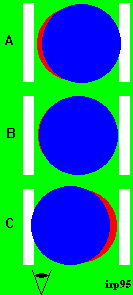

You have to kneel to do this - use the side of your mallet
head
as something to put your knee on if the ground is wet. Once the balls
have
been aligned check again that the balls are in contact - or all
of your precision will be wasted. Not only will it possibly be a fault
in the croquet stroke, it will certainly destroy any aim in the stroke.
Given a flat lawn you can strike the striker's ball and the croqueted
ball
will travel through the hoop.
Consider what happens to the croqueted ball in the stop shot.
When the balls are struck energy is transferred to the croqueted ball
and
it skids away from the striker's ball. After a foot or so it starts to
pick up top spin from its contact with the grass and carries on its
course.
Therefore if you play a peel from say two or more feet from the hoop
then
the peelee will have the distance to pick up spin. If you are playing
an
angled stop shot from a distance closer than this then you would be
advised
to play a gentle stop shot to reduce the distance that the ball skids
before
its starts rolling. If you are straight on to the hoop however then you
can peel hard.

On a heavy lawn (long or wet grass) you may get 1" or more pull on the forward ball over a yard with a roll shot. Consequently you have to aim off. Unfortunately it is up to experience as to how much to aim off for given conditions.
The other croquet stroke which is used to peel balls is a
thick
take off. This is only practicable when the hoop is about a maximum of
a foot away. In the take-off the croqueted ball travels without
appreciable
pull.
It is however a recognised tactic to 'jaws' a ball earlier in the break with the deliberate intention of rush peeling it later. Obviously with a ball in the jaws of a hoop the hittable area of the ball is reduced by the uprights of the hoop.
An Irish peel is a stroke which should be refereed in a serious game since there is the potential for breaking the rules. Typical faults include a double tap, using the edge of a mallet face (only a fault in a hindered stroke) or a crush stroke. A crush stroke is a fault (Law 32a12) where a ball is played into a hoop upright, whilst it is still in contact with the mallet.
The art of peeling is to get the peelee and an escape ball at the hoop. The peel can then be executed in the croquet stroke and the escape ball roqueted in the continuation stroke maintaining the break.
This normally means that you will be playing a three ball break when doing the peel, since the peelee will be 'left behind' after the peel. One instance when this does not happen is on the Rover peel.
The rover peel however can be a minefield - many things can,
and
frequently do, go wrong. It is possible by advance planning to defuse
these
potential disasters. The rover peel is now considered in some detail.
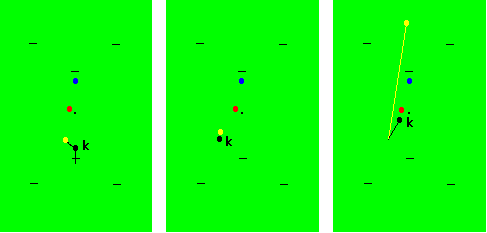
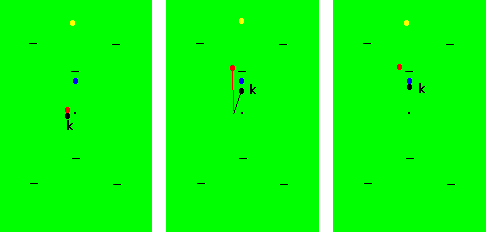
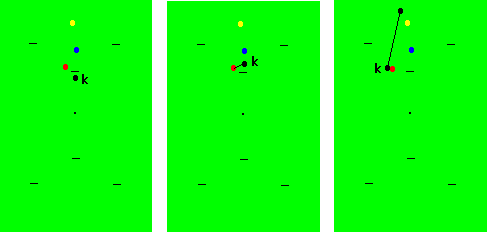
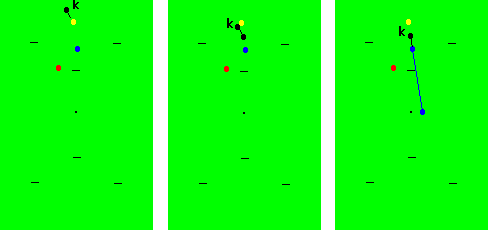
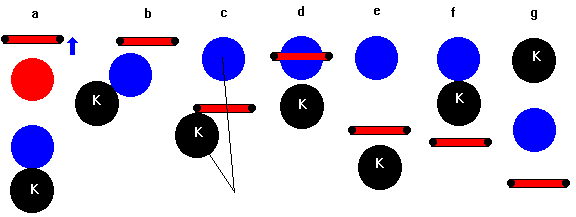
Blue is the ball to be peeled by Black
a). The peel is blocked by another ball
b). Very acute angle for the peel
c). Peel achieved but hoop un-runable
d). Peelee stuck in jaws (with striker's ball close behind)
e). Peelee only just through the hoop
f). Peelee roquet on hoop run
g). Rush back to peg hindered by hoop
Now to take another look at the break illustrated in the last section.
In a jump shot however the striker's ball will hurtle through the
hoop
and run down to the south boundary - to where you have placed the
catcher
ball. This catcher reduces what could otherwise be a difficult 14 foot
return roquet into one of a couple of yards.
a) If the peelee sticks in the hoop you need the space
to do the jump shot. Also the further away from the hoop the striker's
ball is the less chance of encountering disaster b.
b) You would like to use a stop shot to peel since there is
no pull involved. The front ball in a stop shot skids for the first
part
of its travel, then picks up roll. Roll is needed to draw a mis-aimed
ball
through the hoop. Hence a gentle stop shot from a reasonable distance
will
maximise the roll.
c) You want to be able to drive the peelee a good distance
through
rover, say a yard or more. If you are too close to the hoop you cannot
play a reasonable length shot without the striker's ball landing just
in
front or at the hoop.
This tactic should prevent or give options for disasters c-f.
The jump shot can be used to peel a jawsed ball. The striker's
ball is intended to clip the top of the jawsed ball pulling both balls
through (a half jump shot). This has the advantage that a roquet is
deemed
to be made on the peelee only if the balls come to rest in contact
(providing
that the peelee had been roqueted before the jump shot - otherwise you
would either rush-peel the ball or play an Irish peel where both balls
are croqueted through the hoop). A secondary benefit is that the
striker's
ball ends up behind the peelee with a rush in the direction of the peg.
a) If the peelee only goes a short distance through the
hoop, you will have to run the hoop gently stopping behind it (disaster
e). If you do not stop and roquet the peelee then you have real
problems
(disaster f). There are peculiar 'combination peg-outs'
requiring
multiple promotions on the peelee but they are low percentage
manoeuvres.
By having a reception ball to the side you have a ball which you can
roquet if you only just run the hoop.
b) The reception ball is useful near to the peelee because you
can play a croquet stroke with it to promote the peelee off the centre
line of the lawn. This gets you out of disaster g - the hoop
blocking
the peg out.
c) Finally, you may not start a position where the pioneer on
rover is the peelee; the peelee could be the pivot or the reception
ball
from penultimate. This gives you the option of peeling as you go to the
reception ball, provided that the peelee gets into a reasonable
position.
The side reception ball acts as an escape ball for the peel. It can be roqueted after the peel and used to canon the peelee out of the way in the croquet stroke when you adopt hoop running position yourself for rover. It can also be used to canon the peelee through the hoop if it failed to run it completely
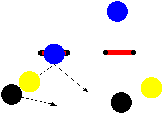
1). The peelee is the pioneer on rover
2). The peelee is pivot, or
3). The peelee is the pioneer on penultimate.
Situation 3 can be avoided by 'swapping pivot' earlier in the break. This is explained in detail in Intermediate Coaching Notes: Changing Pivot in a Four Ball Break .
If however the peelee is your pioneer on penultimate then you want a second ball by penultimate when you run it so that you do not have to roquet the peelee directly after running penultimate. You will be unlikely to have a good rush on the peelee to rover otherwise, straight after running penultimate. Consequently rather than taking off from the pivot to approach the pioneer on penult you roll both balls to penultimate (or get a rush on the pivot to penultimate), then roquet the pioneer/peelee and when approaching the hoop cast it well forward and some way towards the (side) of the peg at the same time as getting hoop running position. This now creates situation 2 above - the peelee can now be considered as the pivot.
For situation 2, where the peelee is the pivot it is essential to get a good rush on it towards rover, alternatively you can arrange to place the pivot closer to rover than the peg.
If when making four back the peelee is the pivot, then you can try to get a rush on it to leave it closer to rover before you make penultimate. There is a good and not-so- good way of doing this. The not-so-good, but adequate method is, after four back, to send the four back reception ball to the side of rover (so as to avoid disaster a. in the diagram!) as a pioneer, whilst getting a rush on the pivot/peelee towards rover. After rushing it close to rover you take off back to the pioneer at penultimate. This has the desired result except you have had to do a 14 yard take off to the penultimate pioneer.
Better, send the four back reception ball to the side of rover and get a rush on the pivot/peelee north of the pioneer on penultimate. The peelee can then be stopped to rover as you approach the pioneer on penultimate. Stop shots are accurate especially in the positioning of the back ball and direction of the front ball.
If your peelee/pivot is not near rover after running penultimate then you have to get a good rush on the peelee which dictates that you must get a prior good rush on the penultimate reception ball to the peelee.
In situation 2 with the peelee as the pivot rushed down to rover you
have the choice of whether you peel
then run rover, or peel
then roquet the pioneer on rover and then run the rover. It is
beneficial
to do the latter as it gives the opportunity to escape from 'disasters
d and g' above.
If you are planning to run rover directly after peeling it is essential that you do not run the hoop and then directly roquet the peelee ('disaster f') Note the Laws though: if both balls run the hoop, as long as they do not end up in contact they are deemed not to have roqueted no matter what happened during the running of the hoop, hence the benefit of an Irish peel. If the peelee is roqueted on the hoop run it will be virtually impossible to peg the peelee out that turn. Consequently the peelee must be sent say 1 yard through the hoop so that you are not left trying to 'just' run the hoop - and then what?
If you have the opportunity to do the peel and then roquet the pioneer then there are some advantages. Firstly a caution: remember pull if you use a roll shot to do a peel then pull will occur and both balls in the stroke will arc towards the aiming line. This is worse for rolls where the balls leave at around 45°.
Situation 1 was discussed above.
The main message is do not peel if it will jeopardise your break.
As an aside the mark of a championship player is when they
achieve
a triple effortlessly with no difficult or risky shots. People who
achieve
a triple with huge split rolls to pioneers can make the triple much
safer
with planning.
Assume that you are starting with a setup four ball break with
the peelee as the pioneer on hoop one.
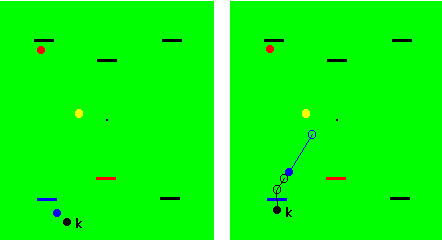
(1). Approach hoop 1 leaving the reception ball to give a rush to
pivot.
(2). Run hoop 1 and rush the reception ball short of pivot.
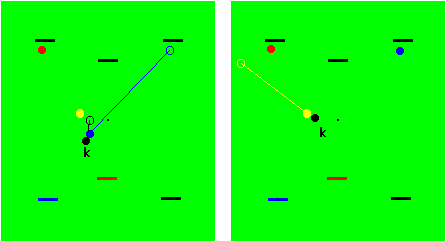
(3), Stop the peelee to hoop 3 whilst getting a rush on the pivot to
the left (west) of hoop 2.
(4). Rush pivot to west boundary
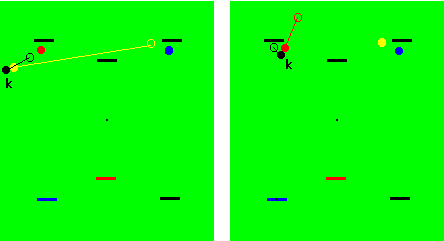
(5). Stop the pivot also to hoop 3 and approach the pioneer on hoop
2.
(6). Approach hoop 2 leaving reception ball to give rush north of hoop
3.
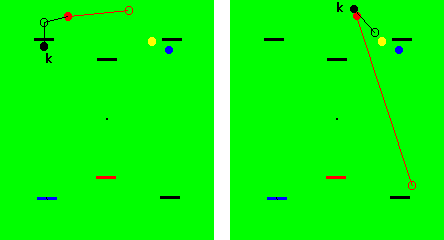
(7). Run hoop 2 and rush north of hoop 3
(8). Stop old reception ball as pioneer on hoop 4 whilst getting
amongst
peelee and pioneer on 3. The detail of ball juggling is left to the
player
... The pioneer becomes the escape ball after the peel.
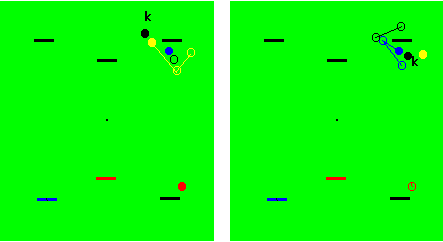
(9). Roquet either peelee or pioneer and croquet in to position.
(10). Roquet remaining ball and whilst placing it in position obtain
hoop running position.
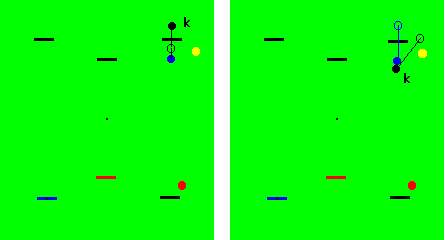
(11). Run the hoop and roquet the peelee.
(12). Peel the ball in the croquet stroke and obtain a rush on the
escape ball down to the left of hoop 4.

(13). Rush down to hoop four and stop the old escape ball as a pioneer
on hoop 5, whilst approaching the pioneer on hoop 4.
(14). Roquet the hoop 4 pioneer and place it to the right of the hoop
to give a rush to north boundary after the hoop run.
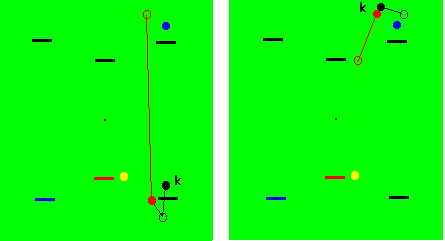
(15). Run hoop 4 and rush the reception ball to the north boundary
between hoops 6 and 3.
(16). Stop the reception ball to the side of hoop 6 whilst getting
a rush on the peelee into the middle of the lawn.
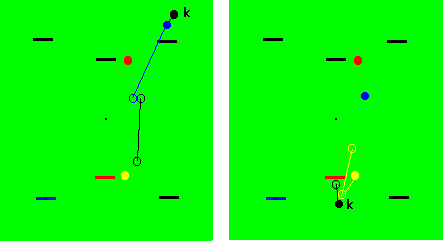
(17). Rush the peelee into the lawn then take off to the pioneer on
hoop 5.
(18). Roquet the pioneer and place a reception ball to be rushed to
the right of the peelee after running the hoop.
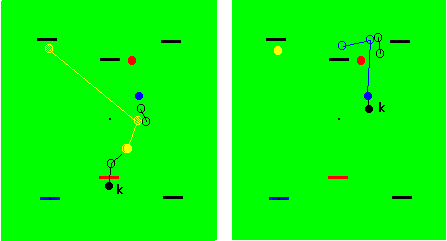
(19). Rush the reception ball to the right of the peelee and stop it
up to 1-back whilst getting a rush on the peelee to hoop six and its
pioneer.
(20). Position the peelee in peeling position behind hoop 6 and roquet
the pioneer.
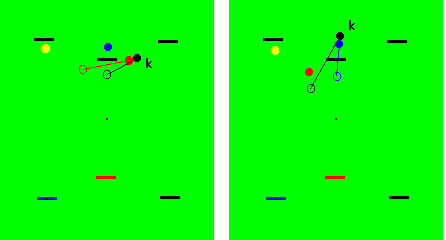
(21). Set the reception ball level with or south of hoop 6 whilst
adopting
hoop running position. This is the escape ball.
(22). Run hoop 6 and roquet the peelee. Peel the ball hard if possible
and come south of the escape ball to give a rush to the north boundary.
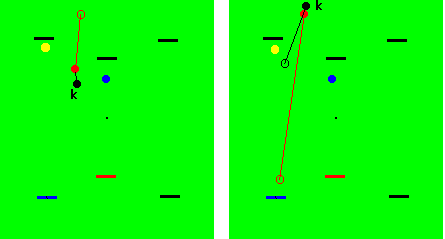
(23). Rush to the north boundary behind the 1-back pioneer, stop the
old reception ball as a pioneer on 2-back and approach the pioneer on
1-back.
(24). Run 1-back and you now have a four ball break around to the peg
during which you can achieve the rover peel as described in the last
section
(situation 2).